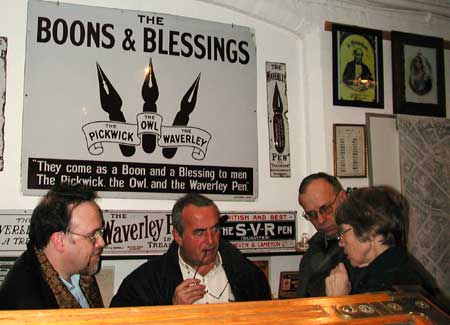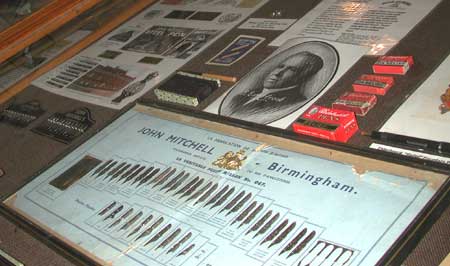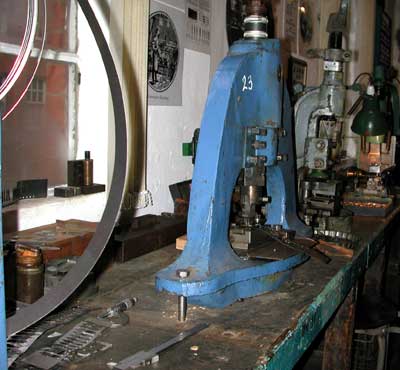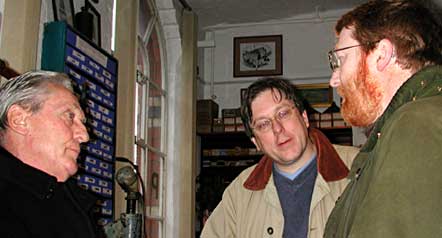
I flew
into Birmingham International Airport for the Writing Equipment
Society Birmingham meeting which took place over a full day
on Sunday 24th Feb. Alan Hobbs from WES kindly collected me
from the airport (and got me back safely).
The day
was divided into two sessions, a presentation on British "own-brand"
pens in the morning at the Royal Birmingham Society of Artists,
Gallery 4 and a tour of the BPTHA (Birmingham Pen Trade Heritage
Association) Pen Room, with an informal trading session in
between.
The morning
session was presented by Steve Hull and gave an insight into
the practice of vintage manufacturers such as Conway Stewart,
Mabie Todd and De La Rue producing runs for wholesalers and
retailers without the normal manufacturer's markings. These
ranged from pens branded with, for example, large department
store names to versions carried by stationery shops which
sold for far less than the identical "branded "
model. One reason for the latter was to keep the factories
producing in times of low demand while still allowing the
original ranges to be sold at premium prices. It didn't stop
there however - many manufacturers sub-contracted the making
of parts to other manufacturing firms, with the result that
it is in effect almost impossible to attribute a manufacturer
to some of these "no-name" pens with any degree
of accuracy. To highlight the complexity of the issue, Steve
brought along in excess of 150 examples, mostly stylos/ink
pencils which are his particular area of interest. Side by
side it was clear that identical pens were produced with different
or no markings or imprints, however the fact that a clip bore
the name Conway Stewart didn't guarantee that is was necessarily
a CS pen. Some appear to have been "manufactured"
by independent small pen firms, while yet others advertised
such goods as sugar, stationery or engineering products. Many
were fine examples of hard rubber finishes (or Vulcanite as
I now understand the correct terminology is in Britain) with
ripple or mottled patterns. Steve also exhibited some examples
of "advertising" pencils which followed the same
pattern. The confusion in terms of identifying these collectables
is compounded by the fact that the boxes and papers could
also carry different branding or model names.

L-R:
Graham Hogg,Steve Hull,Jeremy Collingridge and Maureen Greenland.
Some of
the forty or so attendees brought along examples from their
own collections for possible identification, but as Steve
reiterated - it was a matter of educated guessing rather than
scientific certainty.
In the
afternoon, the group assembled at the Pen Room in the Argent
Centre for a guided tour, conducted by Brian Jones, Secretary
of the Birmingham Pen Trade Heritage Association.
The Pen
Room was officially opened last year in April and is situated
in the Jewellery Quarter of the city. The pen trade in Birmingham
(specifically the manufacture of steel nibs) was a thriving
industry from the eighteen hundreds to the nineteen fifties,
when competition from the ballpoint pen led to it's decline.
The scale of the industry was immense, with over one hundred
companies producing at the peak some 1,500,000,000 steel pens
annually in 100,000 varities, mostly hand pressed and finished.
Today only two of the original pen manufacturers survive -
British Pens and Leonardt.

one
of the display cabinets at the Pen Room
The Pen
Room itself is dominated by huge brass bound oak display cabinets,
rescued from the Birmingham Central Library, with working
hand presses from Leonardt's and British Pens displayed on
original benching from the old Brandauer's factory At one
end is a collection of working steno machines, type writers
and braille machines. I know we have some court reporters
amongst our readers, but even after trying a stenographic
machine I am none the wiser as to how the output makes sense!
You can try your hand at writing with quills or steel pens
and also leave some handwriting samples for grapho-analysis.

Some
of the working nib presses
Every
inch of space is literally packed with exhibits from floor
to ceiling including examples of the "lots" (containers
of the required quantity of output of nibs) produced by the
factory workers which would put some modern factories to shame.
While
there I met Alexander Crum Ewing, author of "The Fountain
Pen - A Collector's Companion" , who has recently moved
from Bonhams and Brooks auction house to Gorringes and Pentracer
Thierry Nguyen (Terry) from Switzerland.

L-R,
Alan Hobbs, Martin Richardson and Alexander Crum Ewing
All in
all a very interesting day even with flight delays on the
way back. Anyone visiting Birmingham should make it a point
to visit the Pen Room, you won't be disappointed!
Further
information:
The
Writing Equipment Society website.
The
Birmingham Pen Trade Heritage Association website.
|


